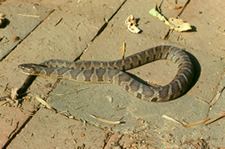Snakes at the Water’s Edge
Do you like to fish, do you live on “the lake”, own a farm pond? If so you will surely come to meet with one, or both, of these critters.
All snakes can and will enter water and swim. But, in the upstate there are two species that can truly be considered “water snakes” because of their preference for living beside permanent water bodies (a preference shared by many people it seems). Of these, the northern water snake is by far the most common. This is the large (up to 3 ft) light brown snake with dark brown/reddish bands and blotches on its back and sides. It’s the one that slides off bushes into the water just ahead of wading fishermen, or that is sometimes under your Jon boat when you lift it to launch from a farm pond shore. They are also commonly seen around docks on the larger reservoirs. If there is shallow water supporting fish or frogs (its preferred foods), this “banded” snake is there too. And its fondness for basking on limbs over the water’s edge frequently results in it being noticed by people.
The northern water snake looks superficially like a copperhead, but on closer examination it is clearly not one. But, “closer examinations” are difficult (if not undesirable), because this snake usually flees into the water at the slightest provocation. The habitat and this escape behavior, as much as anything, can suggest that you have encountered a northern water snake, not a copperhead.
 |
Northern Water Snake (Nerodia sipedon): banded/blotched snake, found in streams, ponds, lakes, 3 |
 |
Queen Snake (Regina septemvittata): olive to brownish snake, yellow on lower sides, usually found only in streams, 2 |
Our second aquatic snake, the queen snake, is not nearly as abundant as the northern water snake, due in part to their habitat and food preferences. The queen snake is a slender dull olive to brownish colored snake with a yellow strip on each lower side. They are creatures of streams (but typically not ponds or reservoirs). This habitat preference is likely related to their habit of feeding almost exclusively on small crayfish, which they find in the shallow rocky areas of the streams. They grow to 30 inches in length.
